awardthe Westinghouse Science Talent Search
June 1, 2020
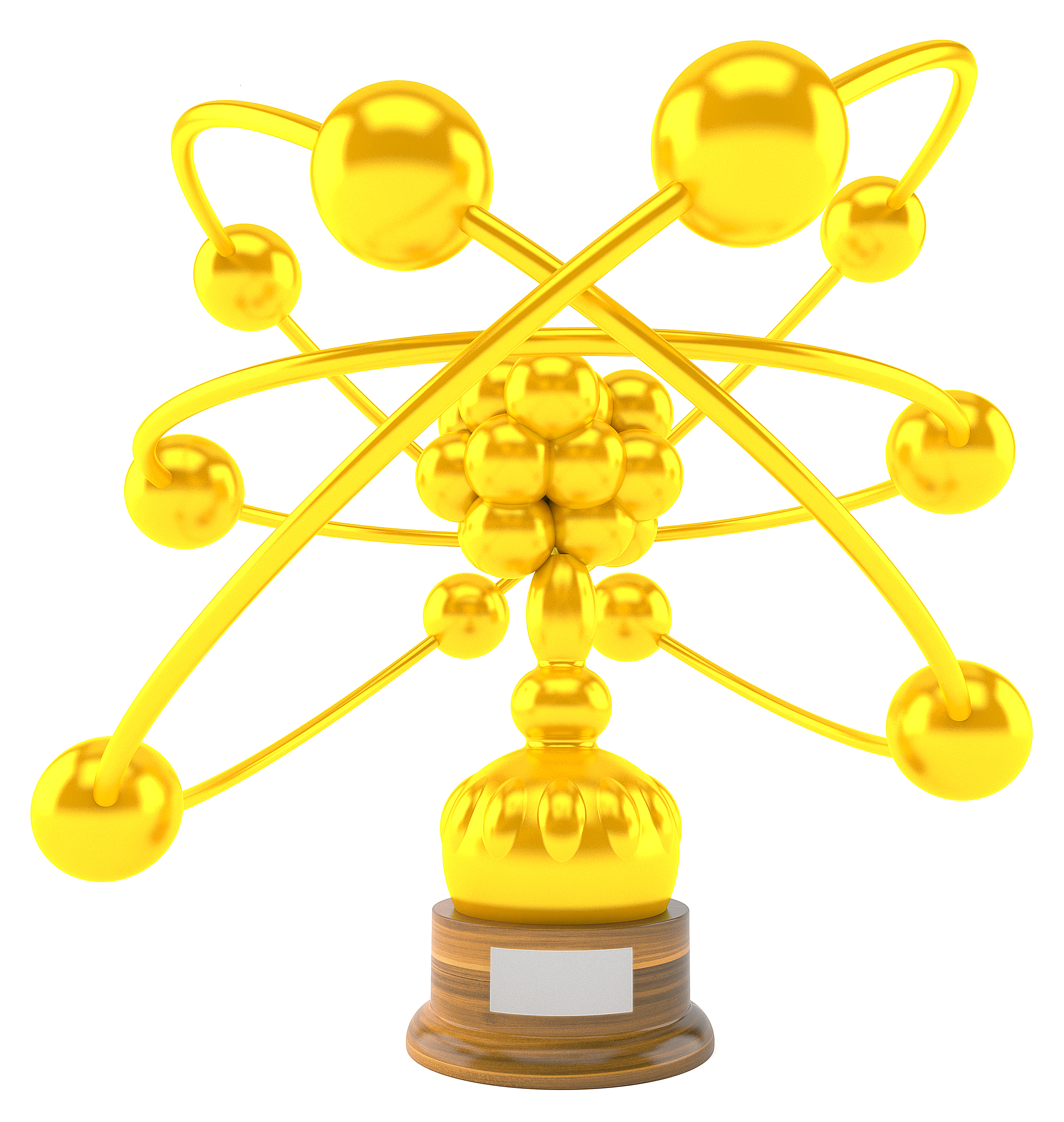
— contents —
~ letter | from Ray Kurzweil
~ about | the competition
~ about | the science project
~ about | the science fair
~ about | the society
~ featurettes
~ interview with Ray Kurzweil | by the Society for Science and the Public
~ historic photos
~ historic brochure
— letter —
Dear readers,
I’m happy to share with you my teen science fair project from year 1965 — when I was just 17 years-old. This time capsule has fond memories of the Westinghouse Science Talent Search — a science fair I attended when I was in high school. There are photos here, of me and fellow students at the event in Washington, DC — with a visit from fmr. US President Lyndon Johnson.
There’s also an interview with me, presented by the organizer of the science fair: the Society for Science and the Public — an historic organization that supports life-long learning. I believe in science + tech education — I hope teens will get to enjoy fairs like this through today’s STEAM schools + programs.
— Ray Kurzweil
about | the competition
competition: the Westinghouse Science Talent Search
date: 1965
contest age range: youth + teen
presented by
the Society for Science and the Public | home ~ channel
tag line: 100 years of impact.
about | the science project
science project title: Simulation of the Creative Process: by computer circuitry
author: by Ray Kurzweil
age: 17 years-old
date: 1965
— description —
A computer program that studies the patterns of songs by famous composers — and then composes original melodies in a matching style.
about | the science fair
The Regeneron Science Talent Search — a program of the Society for Science and the Public — is a youth science research competition in the United States for high school seniors. It’s one of the oldest and most prestigious science competitions.
Youth who enter the competition conduct original science research — sometimes at home and sometimes by interning with teams at universities, hospitals, and private labs. The selection process can include: the research paper, letters of recommendation, essays, test scores, extra-curricular activities, and high school transcripts.
The Society for Science and the Public began the competition in year 1942 with sponsor Westinghouse Electric. The competition was known as the Westinghouse Science Talent Search. In year 1998 Intel became the sponsor. In year 2016 Regeneron became the new title sponsor.
Historically over 150,000 students have entered the competition. The science fair provides a national stage for the country’s young minds to present original research to recognized, professional scientists.
Regeneron | home ~ channel
tag line: From science to medicine.
banner: Push the bounds of science. Make life-changing medicines.
visit | the Regeneron Science Talent Search
visit | the Regeneron International Science + Engineering Fair
tag line: Celebrating and rewarding young innovators.
the science fair | name history
- named: the Regeneron Science Talent Search — 2016 to current
- named: the Intel Science Talent Search — 1998 to 2015
- named: the Westinghouse Science Talent Search — 1942 to 1997
— featurette —
group: the Society for Science and the Public
featurette title: about the Science Talent Search
— featurette —
broadcast: CBS
show title: I’ve Got a Secret
date: 1965
host: Steve Allen
contestant: Ray Kurzweil
description | Ray Kurzweil presents his teen science fair project on the vintage television game show I’ve Got a Secret. His invention was a finalist in the Westinghouse Science Talent Search, in year 1965 — he was 17 years-old.
presented by
CBS | home ~ channel
tag line: A leading, global premium content brand.
the INTERVIEW
story title: A conversation with pioneering inventor Ray Kurzweil.
author: by the Society for Science and the Public
date: 2014
An introduction.
Ray Kurzweil was a finalist in the Westinghouse Science Talent Search in competition year 1965 — for his project titled Simulation of the Creative Process: by computer circuitry. He was 17 years-old.
Since then, he’s followed his dream of becoming a successful author and inventor, and has won many honors: including being inducted into the National Inventors Hall of Fame and receiving the National Medal of Technology. Kurzweil created many inventions to enhance human abilities based on the computer science technique called pattern recognition.
1. |
Kurzweil said:
It seems like only yesterday that I was a science fair finalist like these youth today — but it was half a century ago! I decided to be an inventor when he was just 5 years-old. My parents gave me all these enrichment toys. I knew they were enrichment toys, because they had all these little pieces.
So I took them all apart, and then I went around the neighborhood and found all these other things — like parts of broken bicycles — and added them to my inventory. I just had this feeling that if I could just figure out how to put them all together — that I could make something transcendent.
My first invention was a puppet theater, and then I discovered computers when I was 12 years old. At the time, there were only 12 computers in all of New York city. I was fascinated with the linkages between a computer and the human brain, and my science fair project was based on how I imagined the brain worked — humans use pattern recognition, but computers use logical thinking.
For my project, I created a program that could take existing melodies and create an original melody using the same pattern. That really began my life-long interest in pattern recognition.
2. |
In the 1970s, Ray Kurzweil was working on creating a computer software program that could recognize printed text in any font or type style. The printed letters, numbers, and symbols are called characters — so the technology is called “character recognition.” The software combined with a printed materials scanner is able to recognize the characters: identify words, phrases, and whole sentences.
Kurzweil said:
It was a solution in search of a problem.” Until he sat next to a blind man on an airplane, who complained about being unable to read print materials without assistance, since only 3% of printed books were available in Braille.
He then applied several of his inventions, including a flat-bed scanner, speech and character recognition programs to create a print-to-speech reading machine for the blind, low vision, or disabled people. The amazing device could read aloud any printed material placed on the machine.
Kurzweil said:
That’s when I first deeply noticed the trend in science + technology progress I call the law of accelerating returns, where you apply an exponential trajectory to expectations for technology’s growth. For example: when I was at MIT, they all shared one computer and now an individual mobile phone is several billion times more powerful.
Another big example: mapping the human genome — the complete pattern of DNA that all human biological cells contain — took 7 years to get to 1% complete, but was finished 7 years later. And now you do things to DNA like turn proteins on + off to combat diseases.
Here’s a good example of the power of rapid progress in technology development. In 1968: 1 transistor was available for $1.00 — but now you can get a billion time better quality for the same $1.00. Society has more than doubled our consumption of digital tech because of inventors and innovators, like the science fair finalists, coming up with new ideas by predicting what people will want and need in the future.
3. |
He predicts that in the near future: 3D printing will become common and popular — as people figure out how to use these personal-size ‘solid object’ printers to affordably make new household goods or parts for equipment. He imagines robotic devices the size of blood cells that can enter the human body for therapies like delivering medications.
He also says humans will become smarter — because we will invent ways to expand our minds + bodies, by adding-on digital devices and assistive technologies. But there are also down-sides and risks to humanity as our knowledge and abilities increase.
For example, as we hack the unknown world of biology we could accidentally create a super-virus. We have to keep up with our inventions through new safety guidelines and security.
Kurzweil said:
All science + technology projects ultimately affect people. The leap to being an inventor is when you move away from formulas on paper — I found real joy in seeing changes in people’s lives. And the key to being a good inventor is timing. You have to aim inventions at the world that you can’t yet see.
I encouraged students to remember the always-accelerating pace of progress in your plans. Life will be very different when you finish a project — from how it was when you began your endeavor. Especially with science + technology projects.
So the new tools you’re developing will need to make a contribution to a society that will have a futuristic infra-structure, marketplace, risks, needs, opportunities, and politics — compared to the world you started out with.
— the end —
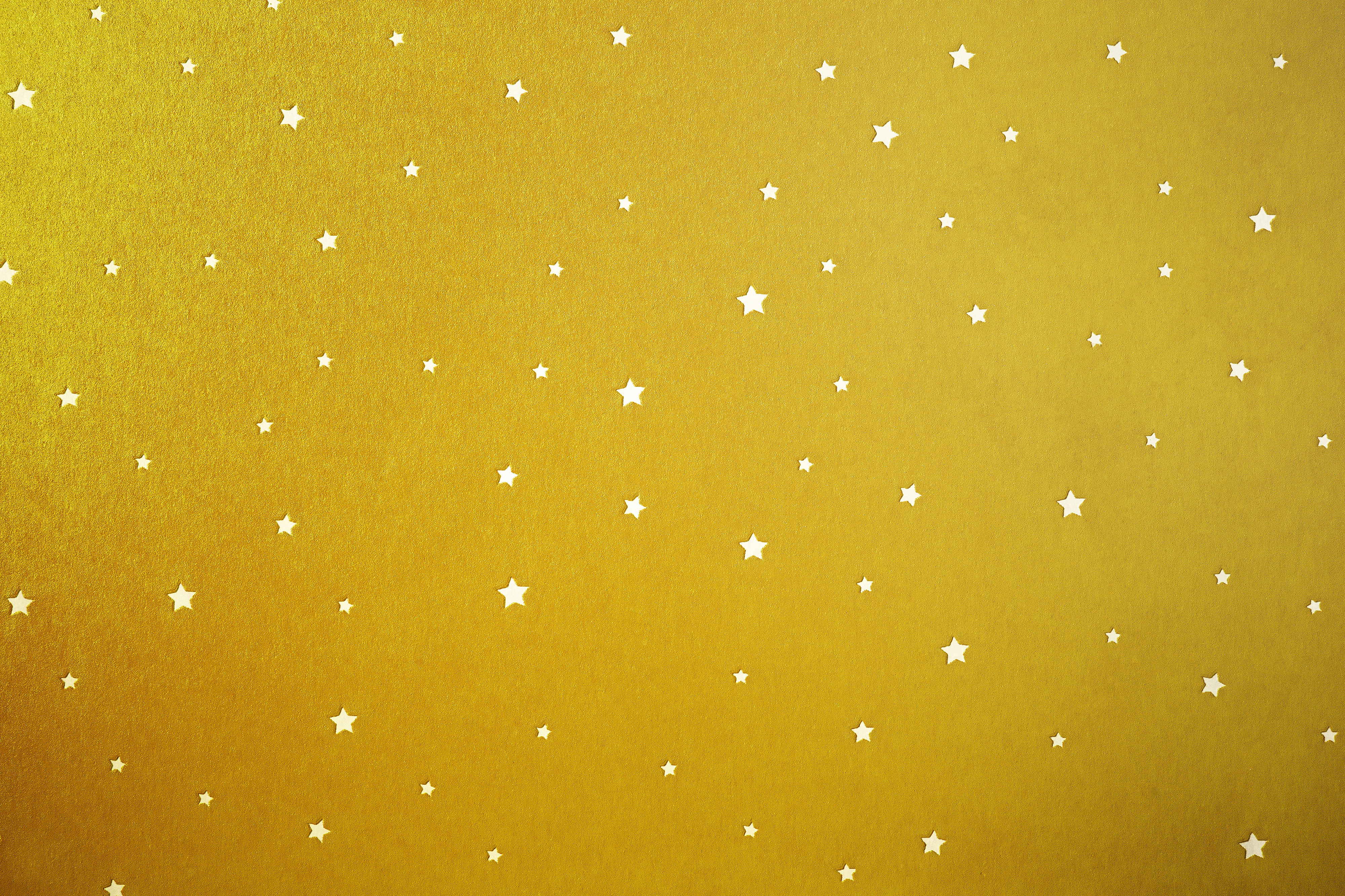
— historic photos —
date: 1965
featuring: Ray Kurzweil + other youth finalists
event: the Westinghouse Science Talent Search
where: Washington, DC | US
source: the Society for Science and the Public
photo | no. 1
Ray Kurzweil on a field trip with the group of young competition finalists.
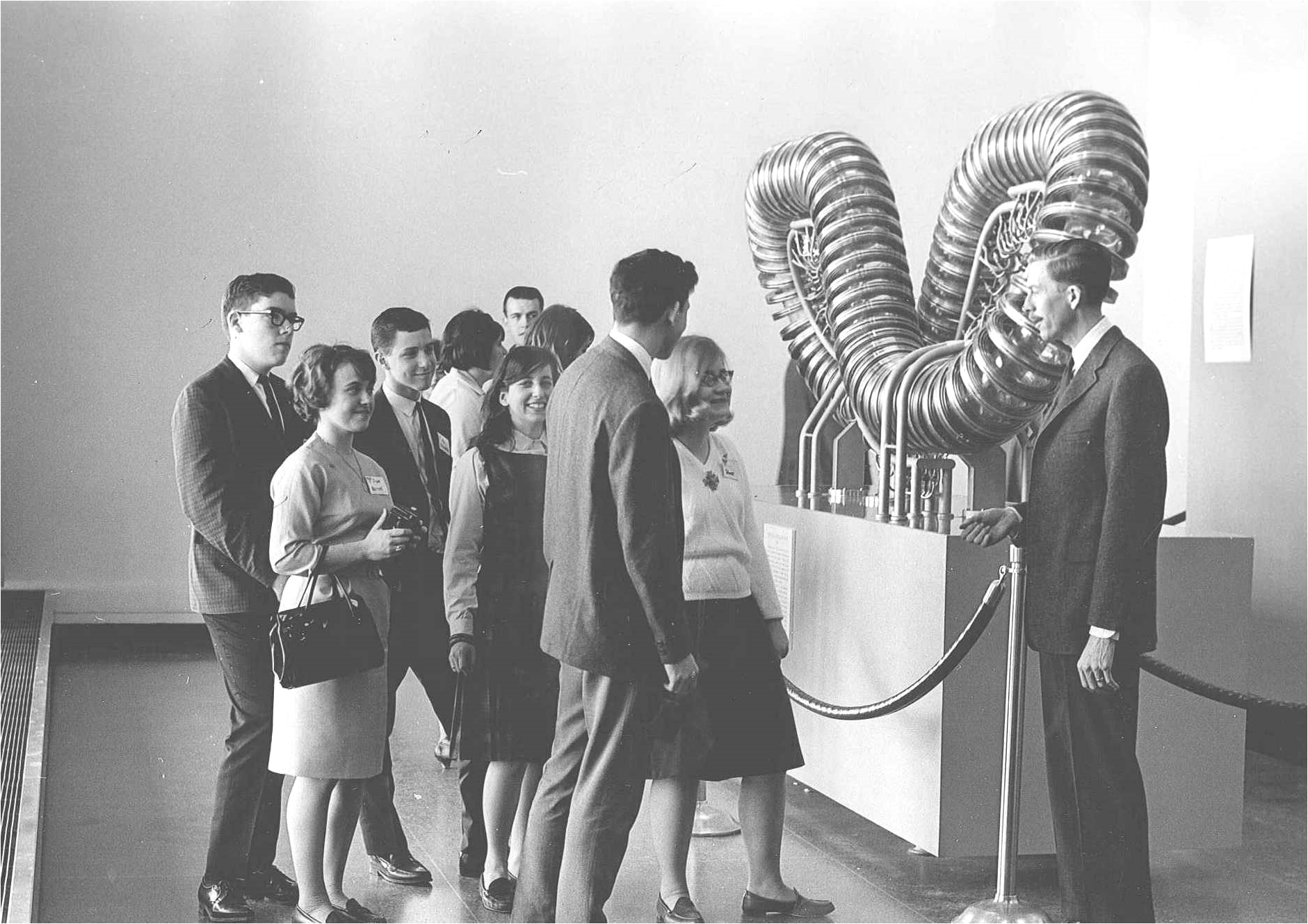
photo | no. 2
Ray Kurzweil with the group of young competition finalists at the White House — with fmr. US President Lyndon Johnson.
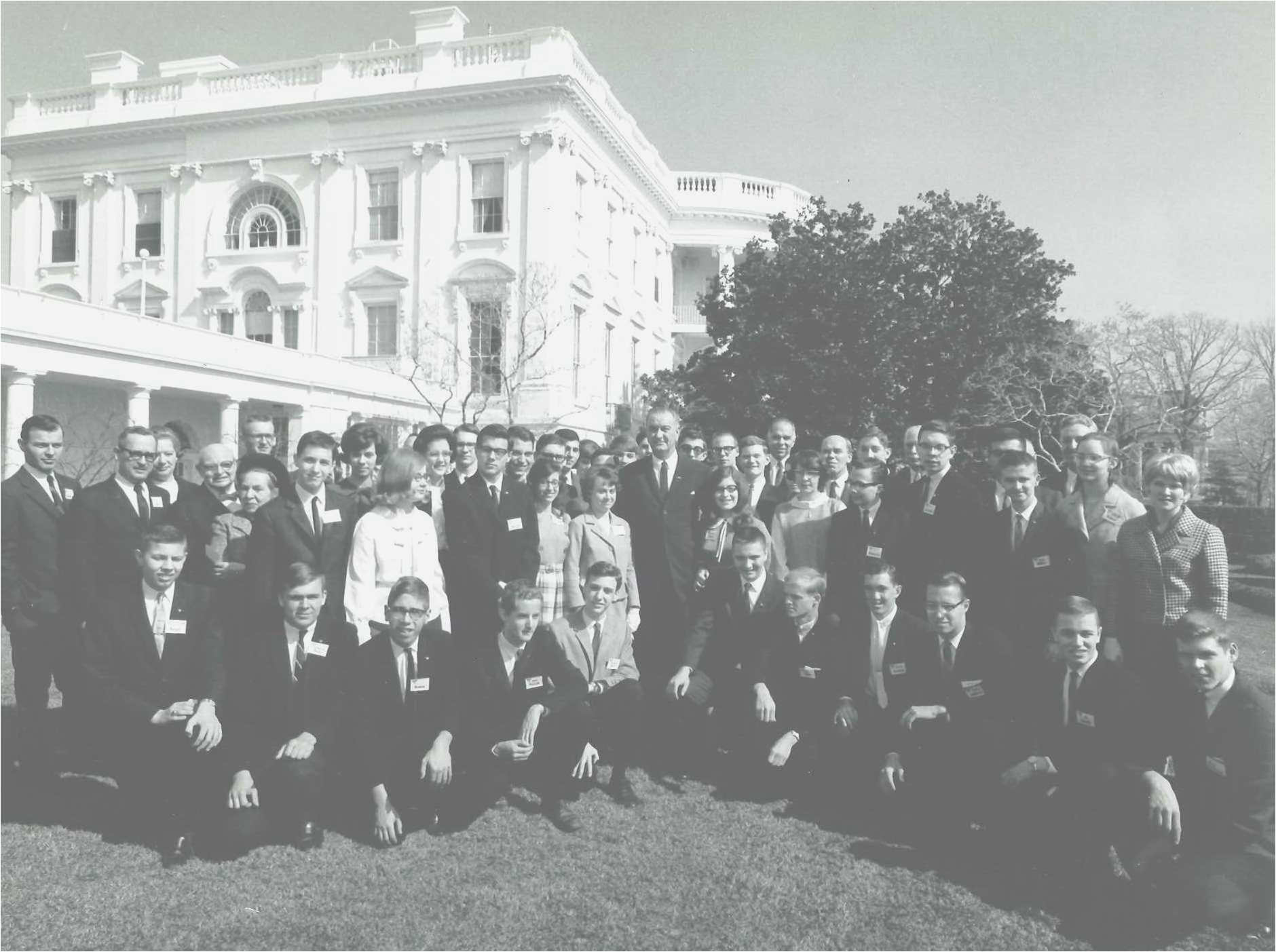
photo | no. 3
Ray Kurzweil with the group of young competition finalists at the White House — with fmr. US President Lyndon Johnson.
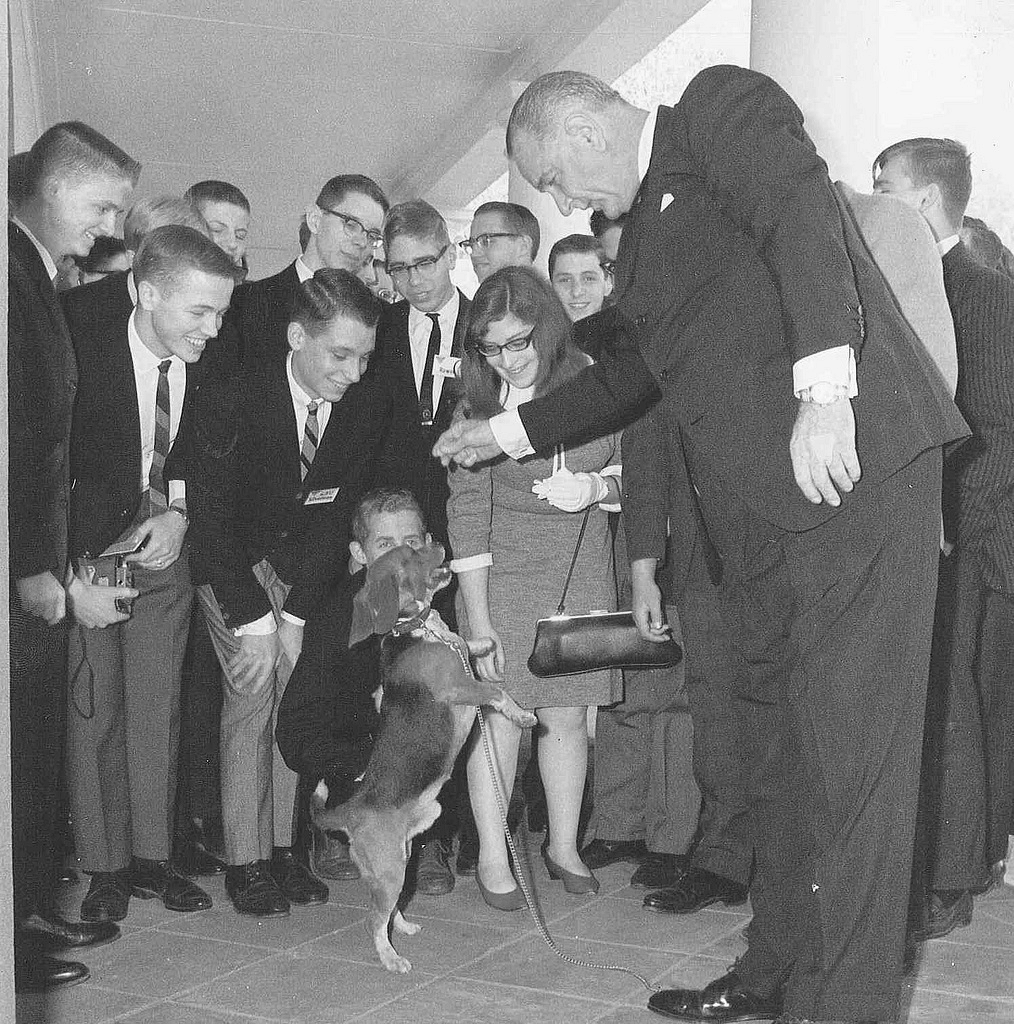
— historic brochure —
The awards brochure for the Westinghouse Science Talent search — year 1965.
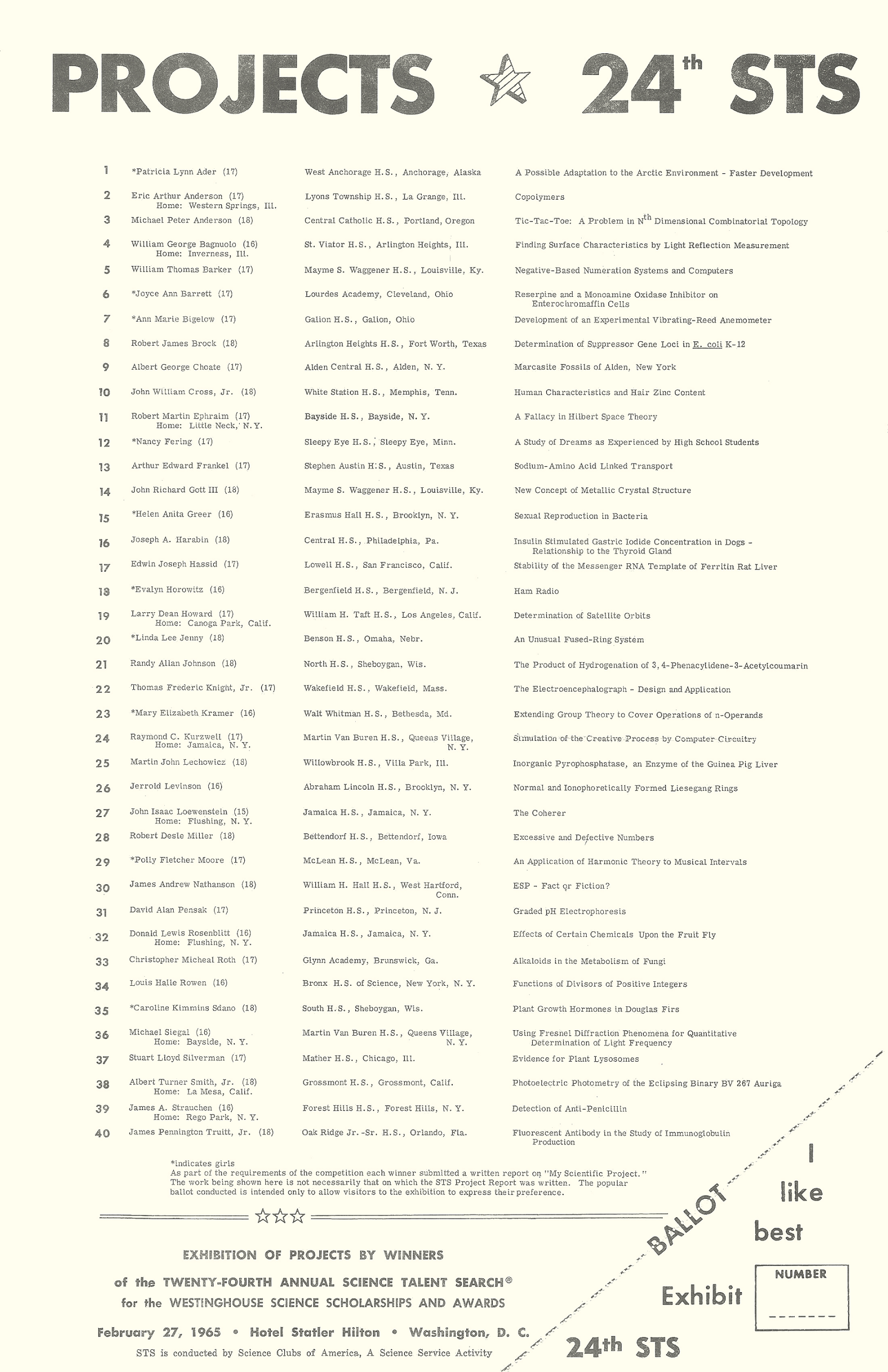
finalists | from year: 1965
student name — home city + home state | in the United States
- Patricia Ader — Anchorage, AK
- Eric Anderson — La Grange, IL
- Michael Anderson — Portland, OR
- William Bagnuolo ~ junior — Mount Prospect, IL
- William Barker — Louisville, KY
- Ann Bigelow — Galion, OH
- Robert Brock — Fort Worth, TX
- Albert Choate — Alden, NY
- John Cross ~ junior — Memphis, TN
- Robert Ephraim — Little Neck, NY
- Nancy Fering — Sleepy Eye, MN
- Arthur Frankel — Austin, TX
- John Gott ~ 3rd — Louisville, KY
- Helen Greer — Brooklyn, NY
- Joyce Gudaitis — Cleveland, OH
- Joseph Harabin — Philadelphia, PA
- Edwin Hassid — San Francisco, CA
- Larry Howard — Canoga Park, CA
- Randy Johnson — Sheboygan, WI
- Thomas Knight ~ junior— Wakefield, MA
- Raymond Kurzweil — Jamaica, NY
- Martin Lechowicz — Villa Park, IL
- Jerrold Levinson — Brooklyn, NY
- John Loewenstein — New York, NY
- Linda Magid — Omaha, NE
- Caroline Mayer — Sheboygan, WI
- Robert Miller — Bettendorf, IA
- Polly Moore — McLean, VA
- James Nathanson — West Hartford, CT
- David Pensak — Princeton, NJ
- Donald Rosenblitt — Flushing, NY
- Christopher Roth — Brunswick, GA
- Louis Rowen — New York, NY
- Mary Schaps — Bethesda, MD
- Michael Siegal — Bayside, NY
- Stuart Silverman — Chicago, IL
- Albert Smith ~ junior— La Mesa, CA
- Evalyn Spitze — Bergenfield, NJ
- James Strauchen — Rego Park, NY
- James Truitt ~ junior — Orlando, FL
- top winner: Larry Howard
- 2nd place: John Gott ~ the 3rd
- 3rd place: Louis Rowen
- 4th place: James Strauchen
- 5th place: Helen Greer
gala speaker: Donald Frederick Hornig PhD
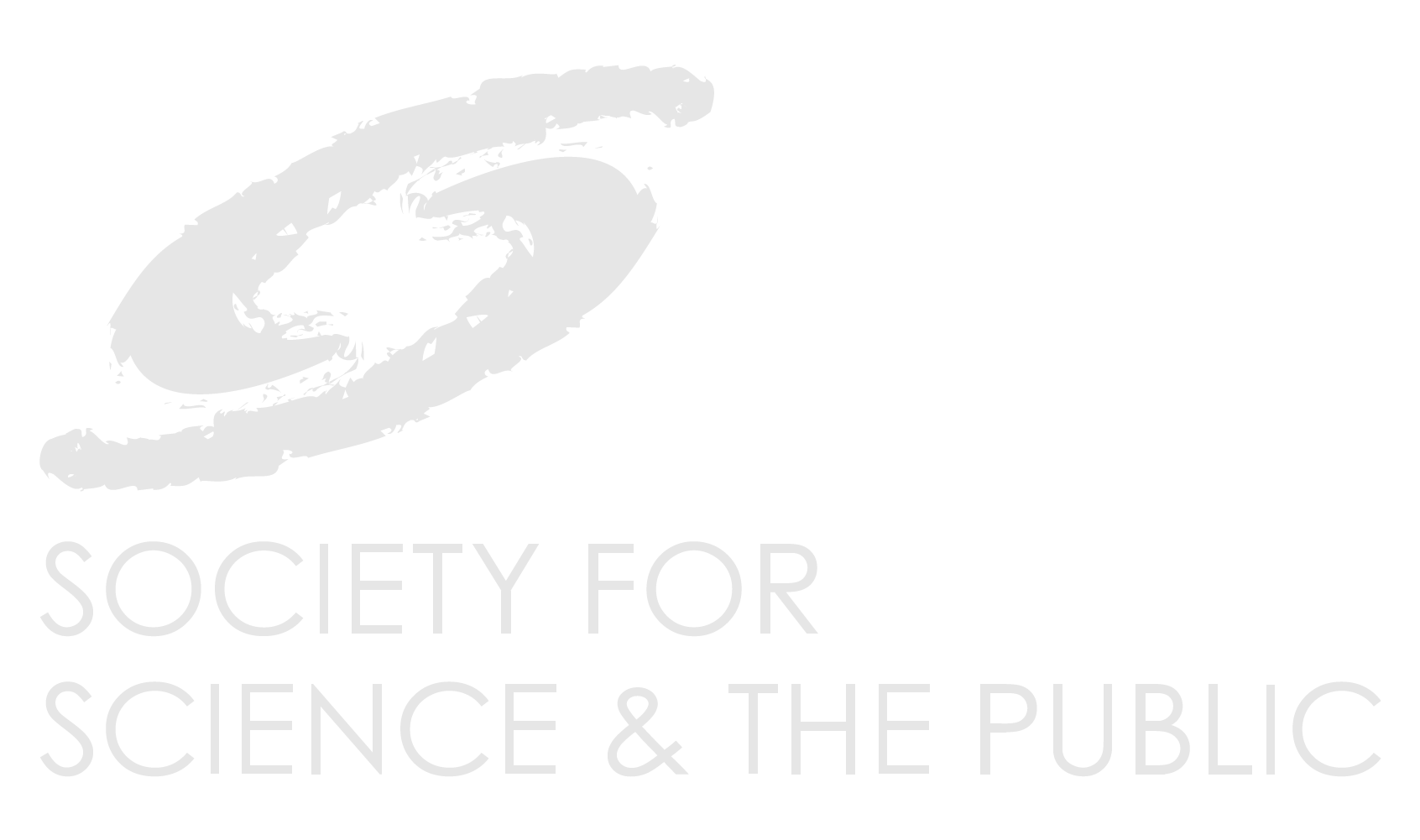
about | the society
The Society for Science and the Public is a champion for science — dedicated to expanding scientific literacy, effective STEAM education, and research. We’re a non-profit membership organization promoting science understanding + appreciation — and the vital role it plays in human advancement: to inform, educate, and inspire.
Since year 1921, the society — originally known as the Science Service — has reached the public through our award-winning publications. And since year 1942, through world-class competitions. Today the society provides educational newsletters world-wide.
the Society for Science and the Public | home ~ channel
tag line: 100 years of impact.
visit | the Westinghouse Science Talent Search: year 1965
visit | The society centennial.
publication
Science News | home ~ channel
tag line: Independent journalism since 1921.
visit | A century of science.
publication
Science News Explores | home
tag line: Providing age-appropriate science news to learners, parents, and educators.
banner: It’s a wonderful world + universe out there.
— notes —
DNA = deoxy-ribonucleic acid
3D = 3-dimensional
STEAM = science, tech, engineering, arts, math or medicine
CBS = the Columbia Broadcasting System
MIT = the Massachusetts Institute of Technology
DC = District of Columbia
US = the United States
LBJ is fmr. US President Lyndon Johnson